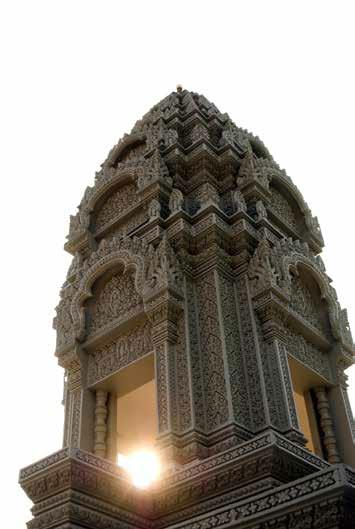Issue:
ONLY IN PHNOM PENH CAN YOU WANDER AROUND MINISTRIES AND KNOCK ON THE DOOR OF AN OFFICE BELONGING TO THE SECRETARY OF STATE.
IN THE RIVER OF TIME, PUBLISHED IN 1995, JON Swain notes that even while Cambodia, Laos and Vietnam were modernizing, “they remain aloof, tragic, beautiful and provocative.”
Nearly 20 years later, the same can be said of Phnom Penh, a city of relative lawlessness and laxity, where the traffic obeys few rules, the streets exude energy, the idea of urban planning is lost on the municipal authorities and tourists occasionally wake up dead in guesthouses from a heroin overdose.
Unlike its two expansive neighbors, Bangkok and Ho Chi Minh City, which have already entered the 21st century with their Skytrains and high rise buildings, Phnom Penh lags years behind. Attempts to bring a functioning bus service to the city have failed. Huge piles of detritus clutter roads, which flood during the wet season.
Cyclo drivers sleep and urinate on the pavement outside government ministries; children run through the rain half naked; power cuts send entire districts of the city into a sweat induced darkness during the hottest months of the year. And all this happens among the frangipani trees and the stained walls of rundown colonial buildings at least in some areas of town. It is exactly this lack of modernity that gives Phnom Penh its edginess and charm.
When some of the old hands from the wars in Vietnam and Cambodia including Elizabeth Becker and Mr. Swain held a reunion in Phnom Penh in 2010 to remember the dozens of journalists who went missing during the 1970-1975 war in Cambodia, they found themselves visiting a city in total transformation. This was a Cambodia undergoing a period of fast capitalist growth and trying to deal with all the injustices that accompany it.
But as James Pringle, the veteran Scottish reporter who worked for Reuters in Saigon, Phnom Penh and also reported from China, Latin America and Africa, said: “Cambodia is one of the last paradises left.”
It was Pringle who described the country as one of “slapstick and horror.” For a reporter, it is this fascinating paradox that makes Cambodia such a fantastic place to work. The spotlight that lit the country prior to its first elections in 1993 went out long ago. But there is still a rich variety of stories to report on: some longtime staples (illegal logging, acts of impunity, land grabbing and human rights abuses), others of a more developing nature (the political impasse since July’s national election and a growing sense of resentment toward Prime Minister Hun Sen’s 28 year leadership).
The wire agencies have largely gone the way of the spotlight. Both Reuters and Agence France Presse have stopped employing expats in their Phnom Penh bureau. But freelancers can do quite well here and there is an active English language local press.
In fact, Phnom Penh is actually “quite a sophisticated little town,” as the manager of a cruise company on the Mekong once said to me as he bought freshly made Belgian chocolates along Street 240, an area of town which has become a haven for expatriates looking to find a boutique fashion shop or who are in need of a guava, passion fruit or dragon fruit smoothie.
Unlike Ho Chi Minh City, a large proportion of Phnom Penh’s colonial architecture is still intact. But Cambodia has left its colonial past behind and is now shrugging off its more recent period of upheaval and political instability.
Young couples on motorcycles the girls on the back dressed in short skirts with hair fashioned like Korean pop stars zoom around the city as the sun sets, a symbol of the country’s booming generation of youth. At night, the more seedy side of Phnom Penh is gathering pace with new hostess bars opening up every other week. High rise buildings are beginning to redefine the capital’s skyline. China is building a new bridge across the Tonle Sap river to cater to the growing number of vehicles entering the city. And modern coffee shops are now filled with the country’s iPad equipped elite.
The distant crack of a Kalashnikov may be harder to hear in Cambodia today, but its not hard to imagine photojournalist Sean Flynn throwing his camera over his shoulder on his way down National Road 1 to meet his death at the hands of the Vietnamese in 1971. War is a part of history, and people in the provinces remain the bearers of many a bewildering story from those horrific years.
Access to information through official channels even the most basic facts is difficult. Good luck on getting the country’s figures on foreign investment if you don’t have excellent sources inside the government’s investment board. On the other hand, only in Phnom Penh can you wander around ministries and knock on the door of an office belonging to the secretary of state. You just have to know how to get one of the country’s old fashioned functionaries to unlock his desk and share what’s inside with the public.
For a reporter in Phnom Penh, life is cheap, and health care non-existent. Palatial apartments go for $400 per month in central areas of town, beers in the bars cost 50 cents and cigarettes go for less than a dollar a pack.
Cambodia may be a small player in the Asean region, but it has plenty of lure for a reporter with a strong appetite for adventure.


